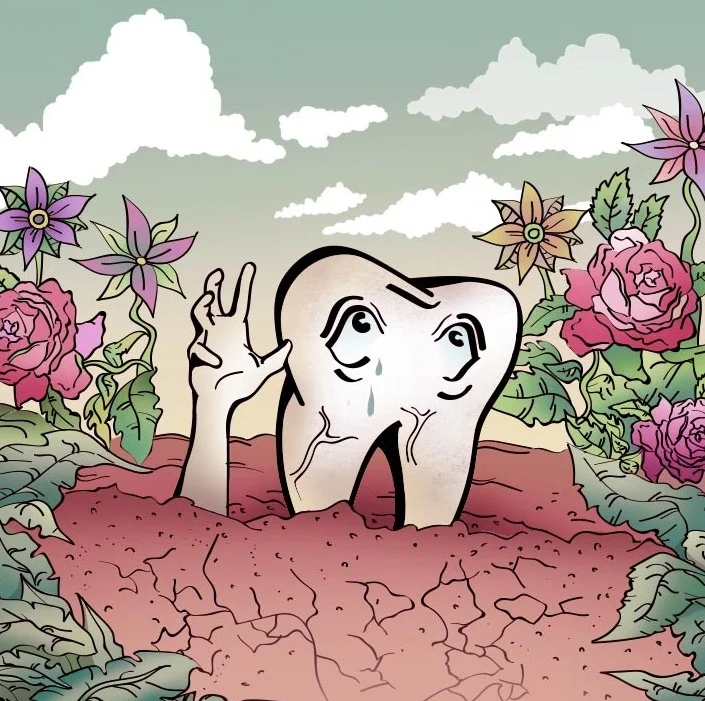Why Hentai Sucks
Even though it’s “make-believe,” Asian women deserve less damaging representation in animated porn.
By Alexa Lee
Hentai is a type of dirty animation that generally depicts characters from manga and anime. (Art: Sam Graap)
Take a look at the most searched-for porn terms in 2017 and it’s likely many keywords will come as no surprise. Tropes like “lesbian” and “cheerleader,” for example, have been the hallmark of sexual fantasies since the beginning of porn, if not time itself.
There is however, a relatively new concept climbing the ranks of porn’s vernacular, and its name is “hentai.” Since 2012, interest in it has more than doubled in the United States, and last year, hentai was the second most-searched-for term on PornHub.
Although in Japanese, hentai is defined as any abnormal sexual desire, in today’s commercial porn industry, hentai refers to sexually explicit or dirty animation. Unsurprisingly, the largest audience that consumes hentai is primarily in East Asia.
But in the past few years, racy cartoons have experienced a massive surge in popularity in the Western world. Now the audience for hentai is geographically and ethnically farther from Asia than ever before. But even though hentai is being increasingly consumed by a diverse, global population, its characters remain distinctly Asian.
As an American woman who is also Asian, I have a problem with this.
It’s not that I believe there is something fundamentally wrong with portraying cartoons having sex. Porn exists to service sexual fantasies, and the medium of animation is merely a creative vehicle for those fantasies.
But most hentai is frighteningly narrow in scope, revolving around the same sexual cliche over and over again: the submissive yet promiscuous young Asian girl. Granted, there are times when hentai does not feature explicitly Asian characters, but it is hard to overlook the porn genre’s precise, racialized focus.
In both Japanese- and Western-produced hentai, female characters are almost always given indigenous-sounding names, like Kyouya and Daisuke, regardless of whether they are blue-eyed blondes or Japanese schoolgirls. Hentai with English subtitles leave Japanese words like “senpai” (used similarly to “daddy”) and “manko” (meaning “pussy”) untranslated, presumably to maintain a certain amount of sexy foreignness. It turns out hentai is not only inextricable from its Asian origins, but its ethnic ties are also a crucial part of its appeal to Western audiences.
This still from the anime TV series Eromanga Sensei is a perfect example of the inane shit female cartoon characters often say in hentai.
Additionally, the women in hentai are often infantilized and weak. They’re portrayed as innocent and submissive to the point of imbecility, while simultaneously characterized as sex-hungry girls on a never-ending quest for dick. On the porn website Hentai Haven, anime women with enlarged eyes and slender adolescent bodies beg the male characters to spank, creampie, and tittyfuck them. Wearing tiny mini skirts and sporting engorged breasts, the cartoon girls make juvenile comments like “I’m gonna go nuts from this pleasure!” and “Wow, my first time sure does feel good!”
Even when they claim to not want sex, women in hentai inevitably orgasm after penetration. This seems to suggest that Asian females don’t know their own sexual impulses and that it is the responsibility of men to forcefully impose sex onto their partners. In the occasional video where a female character is portrayed as sexually assertive, her forwardness is generally depicted as a naughty transgression.
Sex-positive Asian women, it is clear, are more of an exception than an expectation in hentai and other forms of porn.
Some people reading this may be wondering why hentai’s representations even matter. Who cares what type of cartoons people watch during masturbation? Aren’t porn preferences personal to the individual consumer?
But the truth is, online porn is at an unusual intersection between private and public content. Although it fulfills a person’s private sexual interests, ultimately, porn is as accessible and influential as any other form of public media or art.
The way women are represented in porn, specifically the way Asian women are represented in hentai, has an undeniably strong impact on the perception of women in real life.
Hentai markets the idea that Asian women are sexy — because they are weak, youthful, and quiet — to an audience that is largely male and increasingly non-Asian. For many viewers, hentai is a reference point for visualizing Asian women (and for some, it is their only exposure to Asian women at all). Not only are these representations troubling, they’re misleading.
Hentai’s themes of submission and hyper-sexualization reinforce harmful stereotypes about Asian women that bleed into everyday life outside of porn. Such everyday consequences range from the tasteless “yellow fever” comments I hear from my bartenders and Uber drivers, to the ongoing rape culture that Asian women experience as a result of these racist portrayals.
Of course, the image of the hypersexualized, infantilized Asian woman is neither new nor exclusive to hentai. Stigmatizing Asian women as meek yet sexually adventurous dates back hundreds of years; the influence of western imperialism on Asian sexuality is as old as the "Orient" itself. And beyond hentai, this influence remains incredibly powerful, as evidenced by the number of sexy Asian schoolgirl costumes and racially categorized mail-order bride services that litter the Internet.
Similarly, the porn industry in general remains overwhelmingly driven by the male gaze. Even though more women are watching porn, the bulk of it continues to feature them as accessories rather than agents in sex. Asian women are type-cast and pigeonholed in all genres of porn — not just hentai.
But for me, a uniquely unsettling feature of hentai is the complete freedom that animation affords pornographers, and how this total creative liberty can be used to caricaturize Asian women without restraint. Hentai artists do not require the consent of Asian actors in the development of their work. Unencumbered by the logistics of shooting live-action porn, hentai artists are free to portray females however they choose, either by grossly exaggerating their bodies or making them express inane, unrealistic desires. This creative liberty can be used whimsically — I came across several videos, for example, that featured slow motion fireworks and orchestral music when women achieved orgasm — but it can also be used to perpetuate denigrating stereotypes about Asian women and females in general.
As I scroll through video after video of child-like Asian women mounting smug men, I am forced to confront the question, “For whom is this content made?” Certainly not for me, an Asian-American woman.










